
OCTOBER 2005
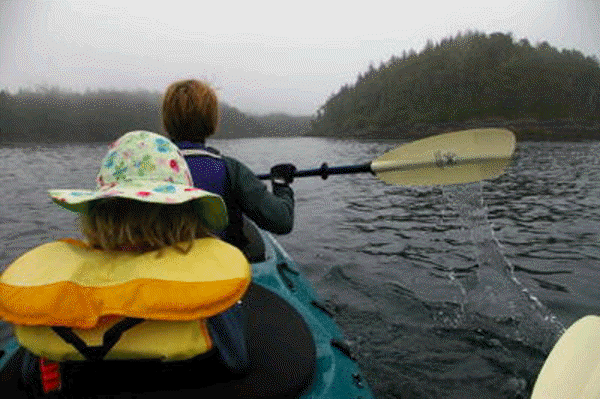
A trip to see the Orca Whales
Part of the trip entailed an interview with Paul Spong, the famed researcher who operates the OrcaLab on Hanson Island. Since there is no easy access to this island, we paddled out by kayak after arranging to camp at the lab site the evening after the interview.
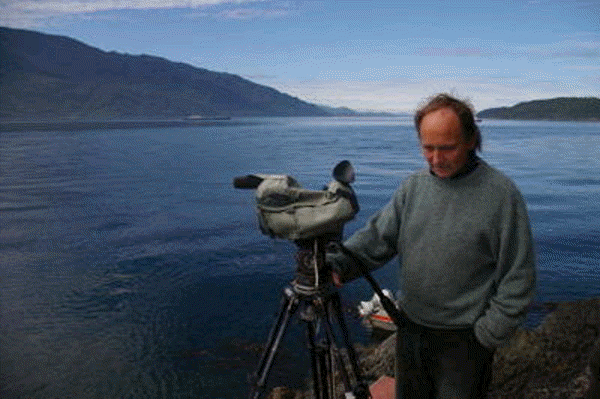
There was a fog hanging over the land masses the morning we left, but the strait was clear and water eerily calm, so we headed out under safe and pleasant conditions, able to see nearly the entire two miles across open water we had to cross.
It was like entering another world, or another time. The fog hung on the rocky shores and draped them like primieval mist. These are places that are unchanged from a millennium ago, and you almost half-expected to see an ancient war canoe emerging from the shroud.
Instead, as we approached the first clump of islands, a school of Pacific white-sided dolphins -- some 20 to 30 of them -- came rushing past us, about a hundred yards distant, and as we watched them cavort past us, the entire school turned and came rushing past directly around our kayak. Some of them, seemingly intent on feeding on herring they seemed to be herding, made the water boil with their hunting, while others leapt out of the air near us.
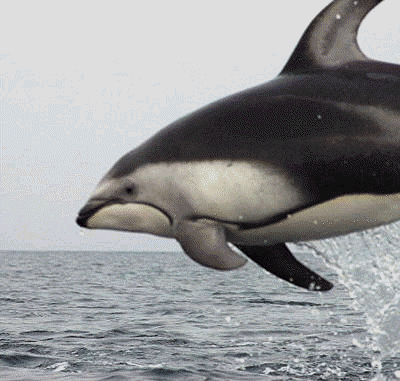
The remainder of our paddle was not nearly as eventful, though we saw plenty of seals and leaping salmon as well, but it was nearly as eerie throughout. The fog only began to lift just as we arrived, three-and-a-half hours later, at the OrcaLab site just south of Burnt Point. Dr. Spong came out to greet us, and directed us hurriedly to our campsite and the lab; he was in a rush to go out diving with his friend Mike Durban, captain of the Blue Fjord, who had pulled his boat into the tiny harbor. This wasn't a pleasure dive; Spong had to perform some emergency repair work on the anchorage at his lab.
A few hours later, after we had set up camp in the beachside forest and settled in a bit, Spong showed us around the main OrcaLab, which overlooks Blackney Passage and is jammed with high-tech gear, manned by a steady stream of volunteers who are on board 24 hours a day, 7 days a week. They're mostly young people, many of them students, with a distinctly international cast: there were two from Germany, one from England, another from France, and three from Japan when we visited.
We sat down and talked for two hours. Spong is a quiet-spoken New Zealander who, aside from being naturally thoughtful, is careful about how he discusses orcas, because he is first a scientist whose chief mission is simply gathering data. Killer whales and the cause surrounding them attract some of the goofier elements of the environmental movement, especially the self-proclaimed animal psychics and the grotesque anthropomorphosis-prone idealists who see them as the equivalent of humans who live in the ocean. Spong is not one of these people, and he seems loath to encourage them.
His chief project, which you can sample at his remarkable site, Orca Live, is monitoring the activities of the northern residents in the inland waters around Hanson Island and Robson Bight, the marine reserve where the whales go to rub. It essentially constitutes recording, through hydrophones, the orcas' communications and echolocation, and to record what smatterings of their above-surface appearances it can obtain through key collection points. None of the hydrophones are located at the lab; rather, they are positioned at stations around the area and transmitted, via satellite uplink, to the main lab at Burnt Point. The cameras, both underwater and above-water, are located at one of the outposts, a rocky reach called Cracroft Point, about a mile away.
It's pure science in the sense that Spong is not necessarily setting out to prove anything; he's simply trying to collect as much data as possible. So far much of this data has proved crucial in understanding the social structure of the northern community, and it played a significant role in the successful reuniting of the young orca named "Springer" with her family in the A11 Pod -- a success that underscored the soundness of the science that's being conducted around these creatures.
We had an exceedingly pleasant evening with Spong and his wife, Helena, as well as the volunteers and the folks who had chartered the Blue Fjord and were anchored in the bay overnight. They all took a liking to Fiona, who was especially impressed at meeting Captain Mike, the hero of one of her favorite books, about the freeing of a humpback whale named Nanoose -- though of course, being 4, she was too tongue-tied to talk.
The next day, as we set out under clear blue sky and utterly calm waters, Spong offered to show us a little of the work at Cracroft Point, so we paddled out that direction and pulled into the rocky point, manned by a young Frenchman named Paul and a Japanese woman named Mari. Spong arrived shortly after. Cracroft, at the tip end of a long, narrow island, offers a fantastic vista of Johnstone Strait and a reasonably clear view of Robson Bight, though about three miles distant. When you log onto the Orca Live site, this is the camera you're likely looking through.
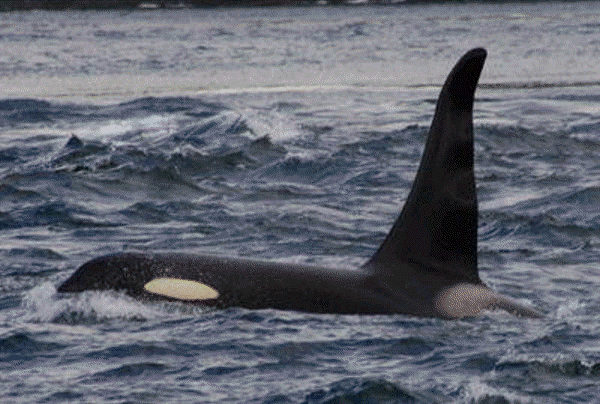
Writer/musician Jim Nollman calls the place where whales and humans meet "the charged border": a place where each set of eyes comes away with something different, often depending on what it's looking for. Yet it is a place fraught with potential, both for understanding our place in the natural world and, perhaps along the way, understanding ourselves better.
So many people approach this border with the baggage of their own expectations, and they often project themselves and their own needs onto these creatures that, for all they really know and in all likelihood, are utterly oblivious to them. Anthropomorphosis pervades so much of our approach to whales that it obliterates seeing the unique whaleness of them.
This is especially true, I think, in aquariums and entertainment venues like Sea World, which do at least have the virtue of letting ordinary people see these creatures up close, and see for themselves the grace and intelligence, not to mention awesome power, they possess. But they are still our captives there, always lesser beings at the mercy of all-powerful humans.
In their native wild, up close, this illusion is shattered utterly. There is no mistaking who is in charge. And unlike humans, who even today still murder whales simply because we can -- there is no remaining legitimate need for whaling -- orcas do not even molest us in their environment. In that regards, were we truly logical, we should probably conclude that these creatures with brains four times the size of ours (and with a proportionate number of cephalic folds), whose intelligence may approach if not exceed ours, and who reside like us at the top of their respective food chain, are probably in fact more civilized. Killer though it may be, the orca does not kill indiscriminately.
In such encounters, the whale crosses the "charged border" in a way that shakes us out of our old ways of thinking, especially our habit of placing man apart from nature, as if we are above it all. Anthropomorphosis may set in later, but at the moment of meeting, our baggage becomes a nullity. These moments give us the opportunity, perhaps, to likewise cross the border, and to reconceive what it means to be human.
I'm reminded of the place the killer whale has in the legends of the First Nations people who dwelt in these waters for centuries before white men arrived. Orcas are a symbol of great power and fertility, and killing them was utterly forbidden (in no small part because it was believed they would wreak horrible revenge on any tribe who did so). Inevitably they are described as spirit beings who occupy their own world, including villages, and observe their own rituals, including dances.
It's important to understand that this is not anthropomorphosis but almost its opposite: Rather than exalting orcas as human-like, these legends conceive of men as occupying the same plane of existence as the rest of nature. Indeed, these same legends tell of ravens and minks and bears and loons as similar spirit beings. The orcas are simply among the most powerful of such spirits, and in some ways the personification of some of the most exalted of all attributes, both in humans and in nature. In many of these legends, they are far more powerful than we puny creatures.
So it is not surprising that the killer whale is a key figure in so much of the art of the Northwest tribes, and the houses of chiefs often featured his visage. Totem poles feature orcas -- readily identifiable, as always, by the big dorsal fin -- prominently, both in museums and genuine Indian villages.
White people, too, seem to have adopted orcas in these parts of the woods. They appear on billboards, and murals adorning entire building walls in Seattle; they're featured in logos and advertisements seeking to elicit that Northwest feel. Orcas are ubiquitous here, even as their actual numbers have continued to decline.
But there's little sense in all these images of even a glimmer of recognition that the orca represents something spiritually powerful or profound (let alone that, in the Puget Sound at least, they are genuinely endangered); rather, it's the same, smiling entertainer who does those amazing tricks for the cameras, the anthropomorphic fellow who symbolizes whatever we want him to symbolize. By implication, the orca remains our inferior, and not our fellow.
This is a worldview -- Man the Conqueror of Nature -- we may not much longer be able to afford. As images of New Orleans, wiped out in a flash of nature's horrible wrath, drench our television
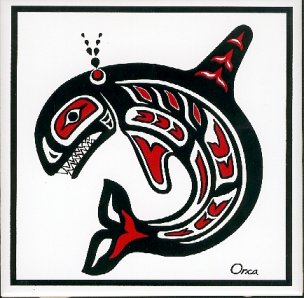 screens,
we continue to comfort ourselves with the notion that we
can still keep a lid on the natural world. We cling
depserately to the conceit that we can separate
ourselves, keep nature at arm's length, even as we
destroy wetlands and chop down forests and pollute our
air in ways that rebound on us, in the end, with
horrifying results.
screens,
we continue to comfort ourselves with the notion that we
can still keep a lid on the natural world. We cling
depserately to the conceit that we can separate
ourselves, keep nature at arm's length, even as we
destroy wetlands and chop down forests and pollute our
air in ways that rebound on us, in the end, with
horrifying results.Hurricanes have a way of destroying such conceits. In a much gentler, and much more hopeful way, genuine encounters with wild things in their native habitats can too. It's all the same lesson. It depends on us, though, to make that border crossing.